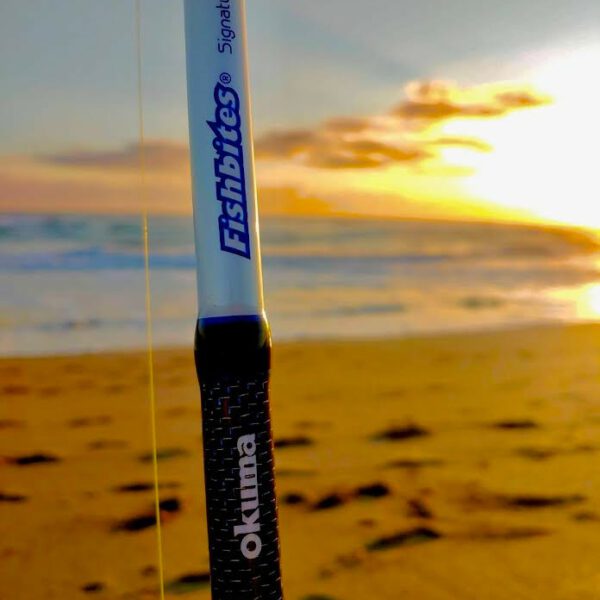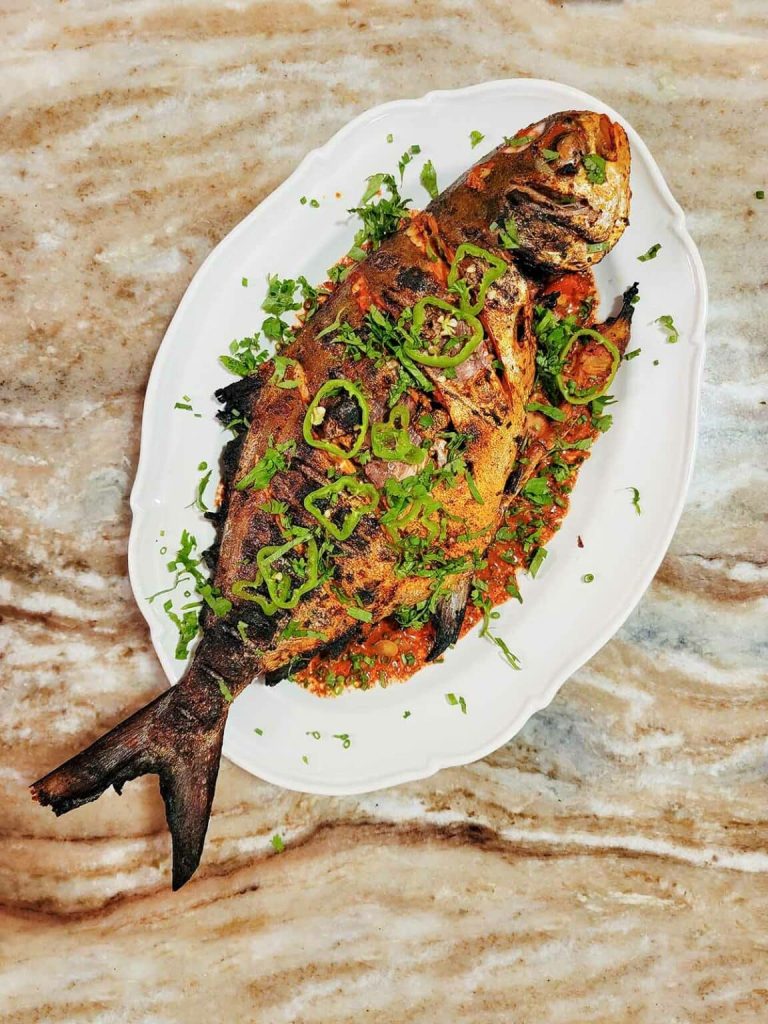The first Florida pompano I ever saw landed was caught by my brother while fishing in the surf for speckled trout. I remember that fish fell to a red and white-bodied 51M Mirrolure. The striking part about that fish was how hard it fought. We had been catching much larger speckled trout all morning and when my brother hooked into that fish, he thought he had a really nice trout because of how much harder it was fighting. Since that day, I’ve always wanted to catch more pompano. But if you want to become skilled at pompano fishing, there’s a lot to learn to get you up to speed.
What is a Pompano?
Pompano is a type of fish that is found in warm waters around the world, including the Atlantic, Pacific, and Indian Oceans. They are highly prized for their delicate, sweet flesh, and are considered a delicacy in many cuisines. There are several species of pompano, but the most well-known is the Florida pompano (Trachinotus carolinus), which is found in the western Atlantic Ocean from Massachusetts to Brazil. Other species include the African pompano (Alectis ciliaris), the Permit (Trachinotus falcatus), and the Pacific pompano (Peprilus simillimus).
State of the Pompano Fishery
The state of the pompano fishery varies depending on the region and species in question. In some areas, pompano populations are healthy and sustainably managed, while in others, overfishing and habitat destruction have led to declines in populations. For example, the Alabama pompano fishery is regulated by the Alabama Department of Conservation and Natural Resources Marine Resources Division. The ADCNR-MRD sets annual catch limits, size limits, and seasonal closures to ensure that the fishery remains sustainable.
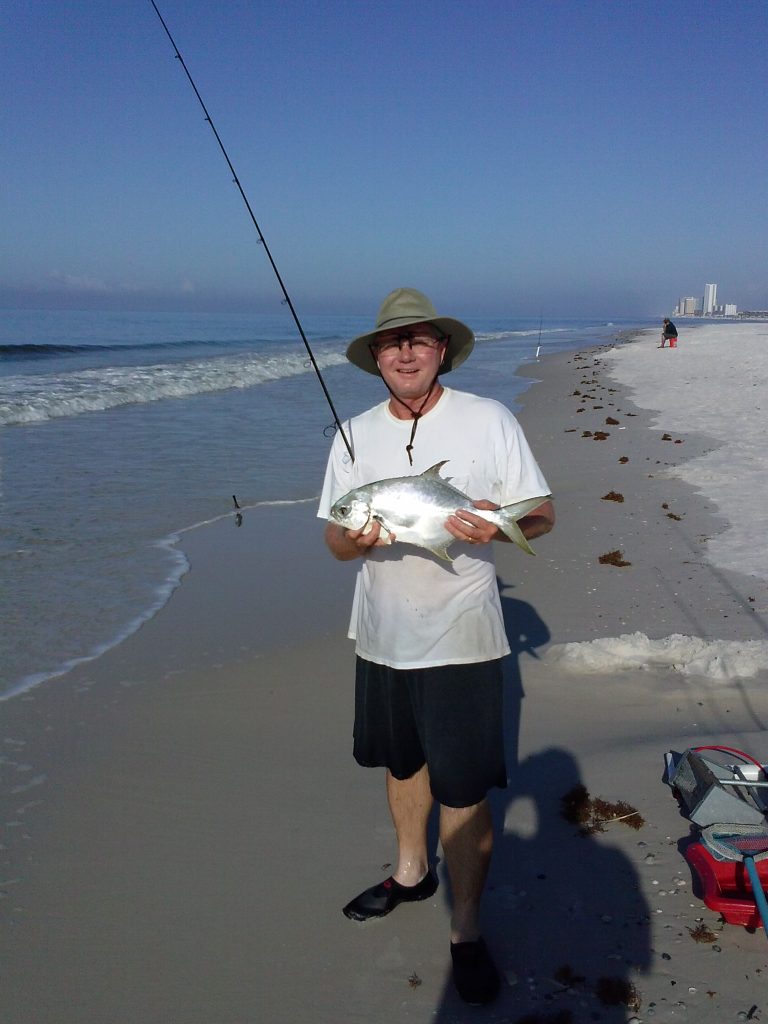
Overall, the state of the pompano fishery depends on the specific species and region in question, but sustainable management practices and conservation efforts are crucial to ensuring that these fish remain a valuable and important part of marine ecosystems and human livelihoods. In Alabama, the Coastal Conservation Association is another group that helps maintain a sustainable pompano fishery. They contribute brood-rearing stock obtained from local fishing tournaments to the Claude Peteet Mariculture Center for restocking efforts.
How Big Do Pompano Get?
Pompano fish size can vary depending on the species, but in general, they are small to medium-sized fish. The Florida pompano typically ranges up to around 4 pounds and a has a length of around 18 to 24 inches. While these are typical sizes, they can grow substantially larger.
World Record Pompano
The IGFA all-tackle world record for a Florida pompano is 8lbs, 4 oz, and was caught October 16th, 1999 by Barry Huston in St.Joe Bay in the Florida Panhandle. While this monster has held the record for 23 years, there is a pending new world record which was caught by Joel Strahm in Vero Beach, Florida. This behemoth weighed 10 lbs 3 oz and will crush the record if certified.
Florida Pompano Identification
In general, pompano have a deep, compressed body shape and a pointed head. They also have a forked tail fin and a single, long dorsal fin that runs along their back. Other identifying features of pompano include their silvery coloration and their small, smooth scales. When trying to identify a specific species of pompano, it is important to pay attention to details such as the shape of the head, the placement of fins, and any distinctive markings or coloration.
Pompano vs Permit
Pompano and permit are two different species of fish and juvenile permit are sometimes confused with pompano due to their similar appearance. However, there are several key differences between the two species. In terms of physical appearance, both pompano and permit have similar body shapes, with a deep, compressed body and a pointed head. The juvenile permit tends to have an orange coloration around the belly whereas the pompano will be more yellow in color. A key giveaway regardless of coloration is the dorsal fin. In the permit, the dorsal fin begins behind the anus whereas in the pompano it begins forward of the anus.
Another difference between the two species is their distribution. While both pompano and permit are found in warm waters around the world, permit are typically found in more tropical regions, such as the Caribbean and the Gulf of Mexico, while pompano are found in both temperate and tropical waters. Finally, there are some differences in the types of habitats that the two species prefer. Permit tend to be found in shallow, sandy flats and grassy areas, while pompano can be found in a wider range of habitats, including beaches, jetties, and inlets.
Jack Crevalle vs Pompano
Jack crevalle and pompano are two different species of fish that can also be distinguished by their physical characteristics and habitat preferences. Jack crevalle are generally larger and more muscular than pompano, with a more robust, thick body and a large, powerful tail. They are typically greenish or bluish-gray in color, with a distinctive black spot on their gill cover. Pompano have a silvery coloration with splashes of yellow whereas a crevalle jack tends to be splashed with more of an orange.
Palometa Vs Pompano
Palometa and pompano are two different species of fish that are sometimes confused due to their similar appearance. However, there are some key differences between the two species. Palometa is a species of jack that is found in warm waters throughout the western Atlantic Ocean, including the Caribbean Sea and the Gulf of Mexico. Like pompano, palometa has a deep, compressed body shape, a forked tail, and silvery coloration. However, palometa has a more elongated and slender body shape, with a more pronounced dorsal fin and a pointed head. The Palometa has vertical stripes on its side and its dorsal and anal fin look long and out of proportion for its body.
What Do Pompano Eat?
Pompano primarily feed on small crustaceans and other invertebrates, such as sand fleas, crabs, ghost shrimp, and small clams. They are bottom feeders and use their small, sharp teeth to crush and grind their food. In addition to their primary diet of invertebrates, Pompano may also eat small fish and other marine organisms if they are available. However, their diet is primarily based on the availability of invertebrates in their habitat.
How to Catch Pompano
Pompano can be caught using a variety of techniques, depending on the specific habitat and feeding behavior of the fish. Pompano are typically found in sandy or grassy areas, such as beaches, jetties, and inlets. Look for areas where the water has good clarity and salinity. Pompano are most active during the early morning and late afternoon when the water is cooler and there is less boat traffic.
Pompano tend to feed more actively during incoming tides, when the water is moving towards the shore and bringing in new food sources. Pompano fishing can require some patience, as these fish are known for their selective feeding behavior. Try different baits and techniques until you find what works best for the conditions and the specific area where you are fishing. Pompano are highly selective feeders, so it’s important to use the right bait to attract them.
Pompano Bait
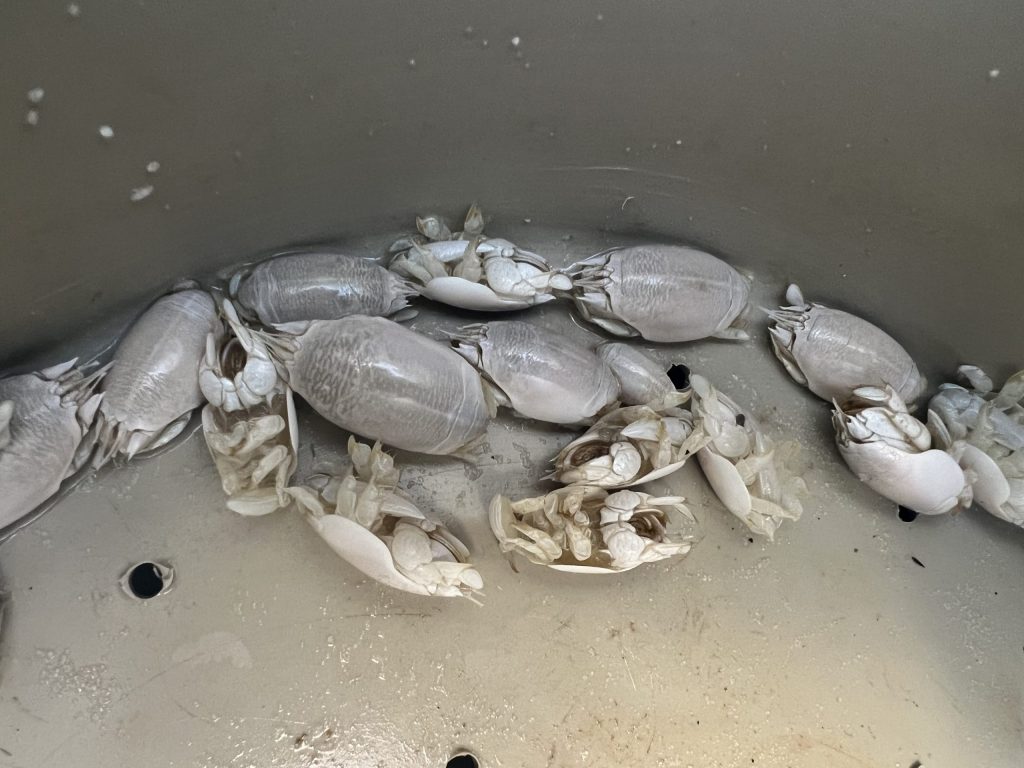
Sand fleas and Ghost Shrimp are widely considered the best bait for pompano in the surf. When fishing with a sand flea, it’s important to hook them correctly so they stay on when cast. Other natural baits include fresh dead shrimp, clams, and Fishbites has an entire lineup of artificial bait and their pompano baits are very effective when used alone or in conjunction with natural baits. They make an excellent tip for natural baits like sand fleas to help them stay on the hook but also to keep you baited if your sand flea comes off. I always keep a few packs in my freezer and in my tackle bag for use with a variety of presentations. Finding the best bait for Pompano takes patience and trial and error, even day to day, but if you have a selection of these types of bait and you put them in the right spots in the surf, they will take one of these offerings if presented correctly.
Fishing for Pompano in the Surf
Pompano are typically found in shallow, sandy areas along the beach. Look for areas where the waves are breaking gently and there is a trough or channel running parallel to the shore. This is where pompano are likely to be feeding. It’s important to cast your bait accurately to these areas and stagger your baits in, beyond, and in front of these areas to find where the fish are feeding that day.
Pompano Rigs for Surf Fishing
There are several types of rigs that are commonly used for pompano surf fishing, but one of the most effective and popular is the classic double-drop pompano rig. Here’s a link to an excellent article on the various pompano rigs and how to choose them. The weight should be just heavy enough to keep the bait in place. When a pompano bites, you may notice your rod bending but if you are using a rod holder, you may also notice your line has gone completely slack. This is because the fish has your bait and is swimming toward shore with it. Quickly get to your rod and begin reeling until you feel tension. Choosing whether to set the hook or reel depends on the style of hook you are using.
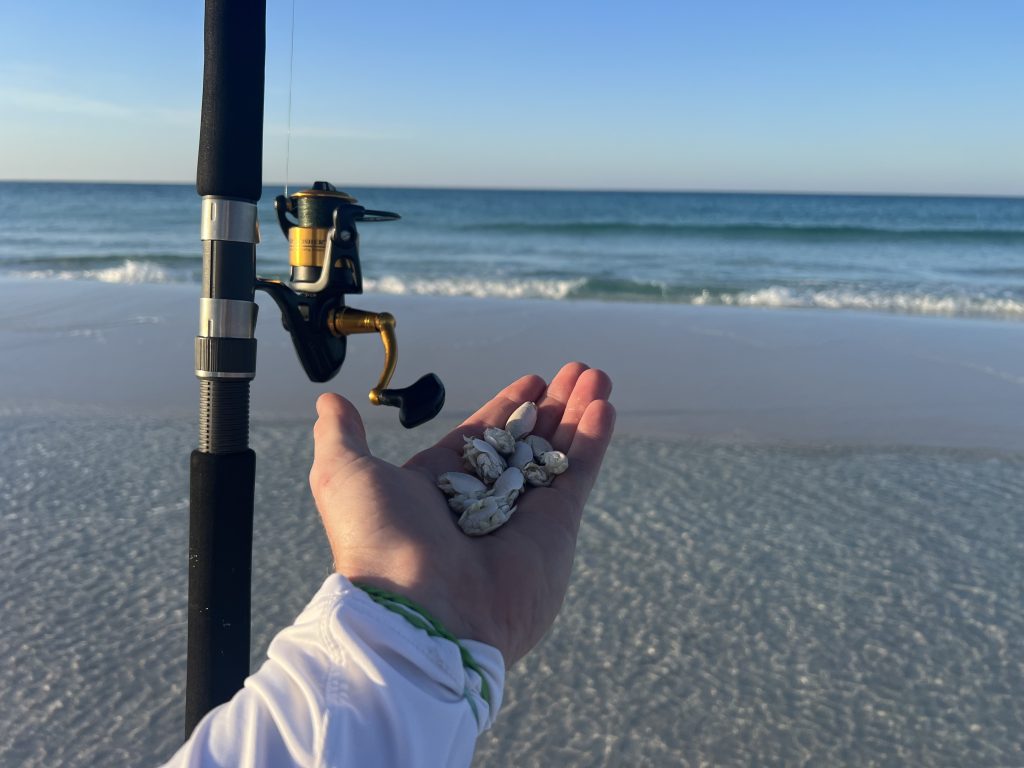
Best Hook for Pompano
Choosing the right hook size and style is an important factor in pompano fishing, as these fish have small mouths and are known for their selective feeding behavior. There are several hook styles that are well-suited for pompano fishing, including circle hooks, J-hooks, and Kahle hooks. Circle hooks are less likely to cause injury to the fish and can increase your chances of a successful hook-up. Some anglers prefer to use hooks with a brightly colored finish, such as pink or chartreuse, to increase visibility and attract more fish to the bait. However, this is largely a matter of personal preference and may not make a significant difference in the success of your fishing.
What Size hook for Pompano
The ideal hook size for pompano will depend on the size of the bait you are using. For smaller baits, such as sand fleas or small pieces of clam, a size 1 or 2 hook is usually sufficient. For larger baits, such as shrimp or cut bait, a size 2/0 or 3/0 hook may be more appropriate. It’s a good idea to bring different hook sizes to find what works best for the bait you are using that day.
Best Rod for Pompano Surf Fishing
The best rod for pompano surf fishing will depend on a few factors, including the conditions of the surf, and your personal preference. Here are some general guidelines to keep in mind:
- Rod length: A rod between 9-13 feet is usually ideal for pompano surf fishing. A longer rod can help you cast farther and keep your line above the surf, while a shorter rod can provide more sensitivity and control when fighting a fish.
- Power and action: A medium power rod with a fast or moderate-fast action is generally best for pompano surf fishing. This will provide enough strength to handle larger fish and the ability to cast with accuracy.
- Line weight: A rod that is rated for 10-30 lb line is usually sufficient for pompano surf fishing. This will provide enough strength to handle larger fish like drum while still providing sensitivity and feel for the smaller bites of pompano.
- Material: Graphite and composite materials are generally the most popular materials for surf fishing rods, as they provide a good balance of strength, sensitivity, and lightness.
- Brand and price: There are many reputable brands of surf fishing rods that are well-suited for pompano fishing, Fishbites makes a great option, seen below:
Fishbites Signature Series Surf Rods
Pompano Jigging
Jigging can be an effective technique for catching pompano, particularly in deeper water or areas where the fish are feeding on small baitfish or other marine organisms. A jig with a weight of around 1/4 to 1/2 oz is usually sufficient. Pompano jigs come in a variety of colors and weights, but generally feature a round head and a small hook.
The Pompano Goofy jig is a style of jig often called a Banana Jig by some. It is an excellent choice for targeting Pompano around inlets and jetties as well as covering ground while surf fishing. If you are looking for a Pompano Jig with a teaser the goofy jig is a good option to add a teaser to or you can find pre-rigged options.
The best color jig for pompano depends on the clarity of the water in which you are fishing. In clear, gin-colored water, white and pink seem to be better producers whereas in more green water Chartreuse seems to have an advantage.
Pompano Season
Pompano season varies depending on the region and location. In Florida, the peak season for pompano fishing is typically in the spring and fall, with the best fishing occurring from March to May and again from September to November. However, pompano can be caught year-round in Florida and in other regions where the fish are found, with the exception of times when water temperatures can drop too low for the fish to be active. During the peak season, pompano can be found in shallow waters along beaches, inlets, and jetties, as well as in deeper waters offshore. It’s important to check local regulations and fishing reports before heading out to fish for pompano, as fishing seasons and catch limits can vary by location.
Pompano Size Limits
It’s important to check local fishing regulations and size limits before heading out to fish for pompano, as these rules can change from year to year and can vary by location. In many states, pompano is considered an incidental catch and has no size or creel limits. While this may be the case, practicing catch-and-release fishing for pompano can help to conserve the fishery and ensure the sustainability of the population for future generations. I love to eat pompano as much as anyone, but they do not freeze as well as other species, so consider only keeping enough for fresh meals and hitting the water more often to replenish your supply.
How to Fillet a Pompano
Filleting a Pompano is fairly straightforward. You will not find that there is anything much different in terms of bone structure that will prevent you from filleting it any differently than most other fish. That being said, pompano is a fish that really lends itself to being grilled whole. So to do that, you will not need to fillet your pompano, you will only need to remove the guts and gills and also scale and score the fish. While pompano scales are very small, the final product will be much nicer if you go ahead and scale your fish. Check out this video for a step by step look at how to clean a pompano.
Pompano Recipes
Some regard the Pompano as the finest-eating fish in the Gulf of Mexico. I also find it interesting that many people do not like pompano at all. What I have learned over the years is that pompano is a delicious fish, but it does lend itself to being prepared in ways that most cooks are not as familiar with, namely cooking whole. If you are wanting to have a fish fry, there are other species that will be much better in this regard. I recently took my good friend Hank Shaw on a Florida pompano fishing trip and was lucky enough to try this recipe firsthand. If you are looking for a simple, crowd-pleasing recipe that accentuates the type of meat that Pompano provides, check out his recipe here.
Final Thoughts on Pompano Fishing
Pompano fishing can be a rewarding and enjoyable experience for anglers of all skill levels. These fast and feisty fish are known for their delicious flavor and hard-fighting nature, making them a popular target for both recreational and commercial fishermen. Whether you’re fishing from shore or a boat, using live or artificial bait, or jigging, there are many techniques and strategies that can be effective for catching pompano. It’s important to be observant, and adaptable to changing conditions and do your scouting for areas that will be more productive. By using the right gear, bait, and technique, and by staying informed about the latest tips and trends in pompano fishing, you can increase your chances of success with this hard-fighting and beautiful fish.
Full Disclosure: This post may include affiliate links. There’s no extra charge to our readers for using these.


